Cross-Cultural Communication and Business Relations: A Case Study
VerifiedAdded on 2021/04/19
|6
|2112
|77
Report
AI Summary
This report analyzes the critical role of cross-cultural communication in international business, specifically focusing on the challenges and opportunities of entering the Chinese market. It examines the importance of understanding Chinese business etiquette, including meeting protocols, relationship building, and decision-making processes. The report also explores the impact of cross-cultural miscommunication and the significance of cultural frameworks, such as Hofstede's model, in navigating cultural differences. By comparing Australia and China across Hofstede's dimensions, the report highlights key cultural differences that impact business interactions. It provides recommendations for successful cross-cultural communication, emphasizing the importance of cultural knowledge, non-verbal communication, and open-mindedness. The report concludes by underscoring the significance of cross-cultural understanding for successful market penetration and business expansion, using a case study of 'The Aroma Shop' to illustrate practical application.
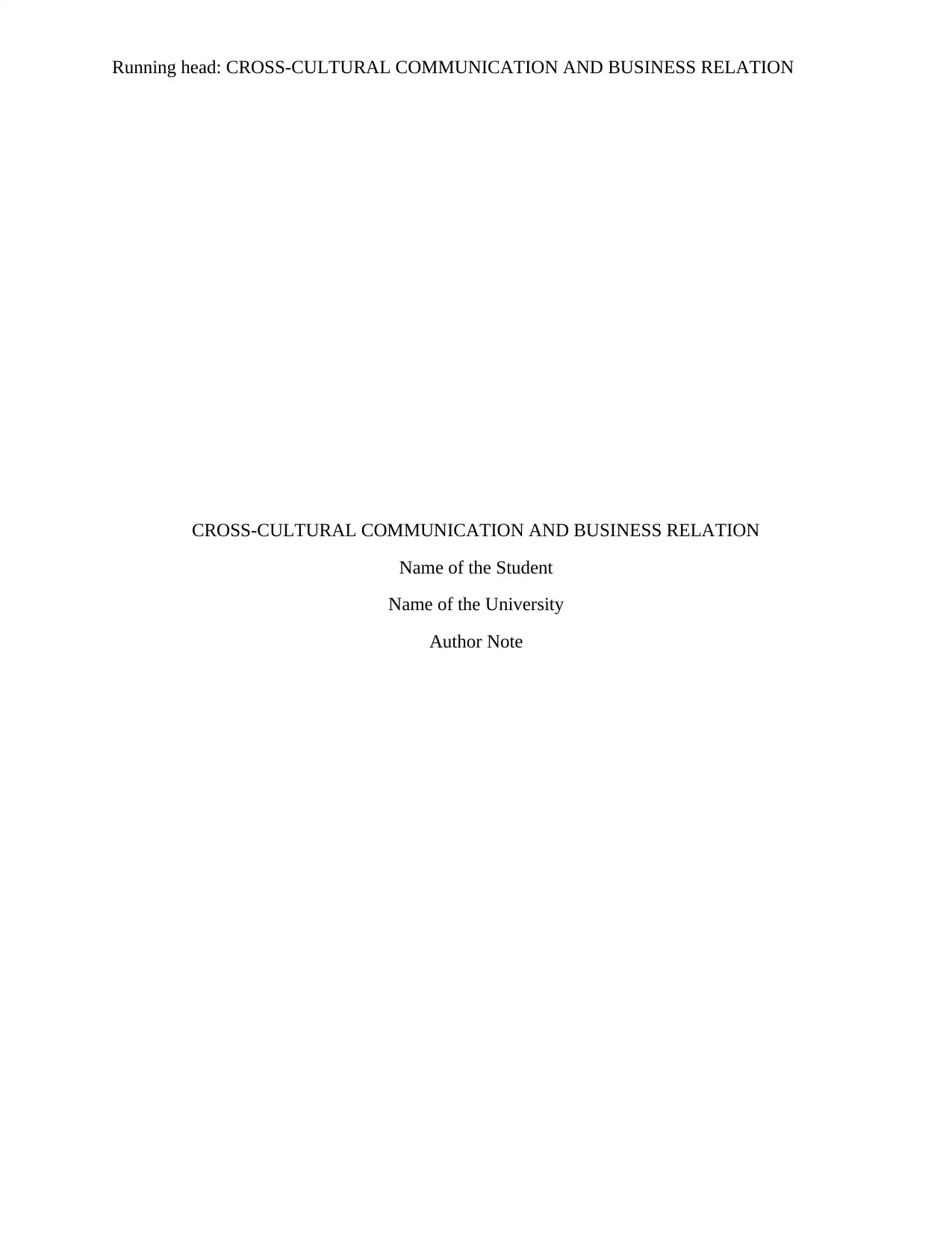
Running head: CROSS-CULTURAL COMMUNICATION AND BUSINESS RELATION
CROSS-CULTURAL COMMUNICATION AND BUSINESS RELATION
Name of the Student
Name of the University
Author Note
CROSS-CULTURAL COMMUNICATION AND BUSINESS RELATION
Name of the Student
Name of the University
Author Note
Paraphrase This Document
Need a fresh take? Get an instant paraphrase of this document with our AI Paraphraser
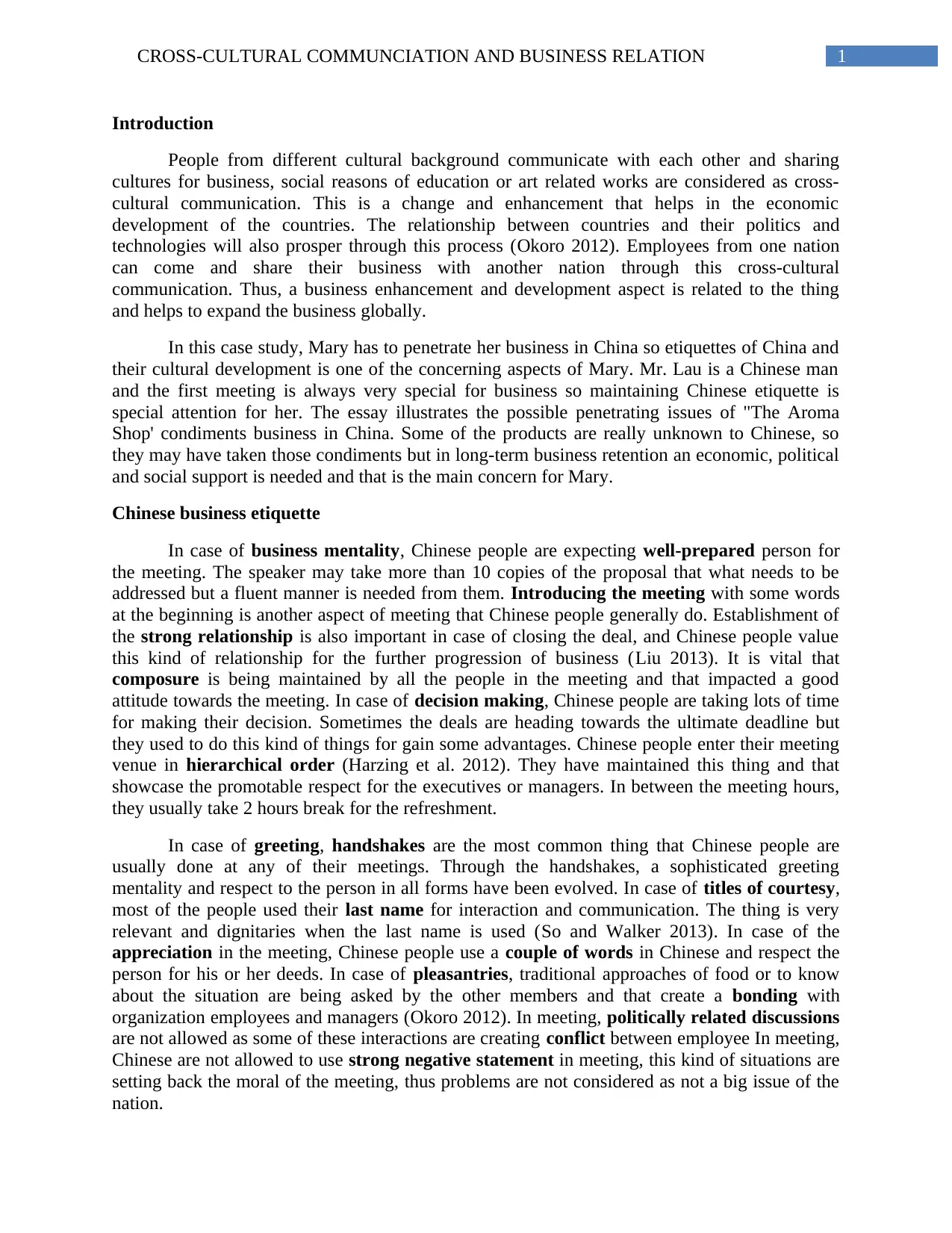
1CROSS-CULTURAL COMMUNCIATION AND BUSINESS RELATION
Introduction
People from different cultural background communicate with each other and sharing
cultures for business, social reasons of education or art related works are considered as cross-
cultural communication. This is a change and enhancement that helps in the economic
development of the countries. The relationship between countries and their politics and
technologies will also prosper through this process (Okoro 2012). Employees from one nation
can come and share their business with another nation through this cross-cultural
communication. Thus, a business enhancement and development aspect is related to the thing
and helps to expand the business globally.
In this case study, Mary has to penetrate her business in China so etiquettes of China and
their cultural development is one of the concerning aspects of Mary. Mr. Lau is a Chinese man
and the first meeting is always very special for business so maintaining Chinese etiquette is
special attention for her. The essay illustrates the possible penetrating issues of "The Aroma
Shop' condiments business in China. Some of the products are really unknown to Chinese, so
they may have taken those condiments but in long-term business retention an economic, political
and social support is needed and that is the main concern for Mary.
Chinese business etiquette
In case of business mentality, Chinese people are expecting well-prepared person for
the meeting. The speaker may take more than 10 copies of the proposal that what needs to be
addressed but a fluent manner is needed from them. Introducing the meeting with some words
at the beginning is another aspect of meeting that Chinese people generally do. Establishment of
the strong relationship is also important in case of closing the deal, and Chinese people value
this kind of relationship for the further progression of business (Liu 2013). It is vital that
composure is being maintained by all the people in the meeting and that impacted a good
attitude towards the meeting. In case of decision making, Chinese people are taking lots of time
for making their decision. Sometimes the deals are heading towards the ultimate deadline but
they used to do this kind of things for gain some advantages. Chinese people enter their meeting
venue in hierarchical order (Harzing et al. 2012). They have maintained this thing and that
showcase the promotable respect for the executives or managers. In between the meeting hours,
they usually take 2 hours break for the refreshment.
In case of greeting, handshakes are the most common thing that Chinese people are
usually done at any of their meetings. Through the handshakes, a sophisticated greeting
mentality and respect to the person in all forms have been evolved. In case of titles of courtesy,
most of the people used their last name for interaction and communication. The thing is very
relevant and dignitaries when the last name is used (So and Walker 2013). In case of the
appreciation in the meeting, Chinese people use a couple of words in Chinese and respect the
person for his or her deeds. In case of pleasantries, traditional approaches of food or to know
about the situation are being asked by the other members and that create a bonding with
organization employees and managers (Okoro 2012). In meeting, politically related discussions
are not allowed as some of these interactions are creating conflict between employee In meeting,
Chinese are not allowed to use strong negative statement in meeting, this kind of situations are
setting back the moral of the meeting, thus problems are not considered as not a big issue of the
nation.
Introduction
People from different cultural background communicate with each other and sharing
cultures for business, social reasons of education or art related works are considered as cross-
cultural communication. This is a change and enhancement that helps in the economic
development of the countries. The relationship between countries and their politics and
technologies will also prosper through this process (Okoro 2012). Employees from one nation
can come and share their business with another nation through this cross-cultural
communication. Thus, a business enhancement and development aspect is related to the thing
and helps to expand the business globally.
In this case study, Mary has to penetrate her business in China so etiquettes of China and
their cultural development is one of the concerning aspects of Mary. Mr. Lau is a Chinese man
and the first meeting is always very special for business so maintaining Chinese etiquette is
special attention for her. The essay illustrates the possible penetrating issues of "The Aroma
Shop' condiments business in China. Some of the products are really unknown to Chinese, so
they may have taken those condiments but in long-term business retention an economic, political
and social support is needed and that is the main concern for Mary.
Chinese business etiquette
In case of business mentality, Chinese people are expecting well-prepared person for
the meeting. The speaker may take more than 10 copies of the proposal that what needs to be
addressed but a fluent manner is needed from them. Introducing the meeting with some words
at the beginning is another aspect of meeting that Chinese people generally do. Establishment of
the strong relationship is also important in case of closing the deal, and Chinese people value
this kind of relationship for the further progression of business (Liu 2013). It is vital that
composure is being maintained by all the people in the meeting and that impacted a good
attitude towards the meeting. In case of decision making, Chinese people are taking lots of time
for making their decision. Sometimes the deals are heading towards the ultimate deadline but
they used to do this kind of things for gain some advantages. Chinese people enter their meeting
venue in hierarchical order (Harzing et al. 2012). They have maintained this thing and that
showcase the promotable respect for the executives or managers. In between the meeting hours,
they usually take 2 hours break for the refreshment.
In case of greeting, handshakes are the most common thing that Chinese people are
usually done at any of their meetings. Through the handshakes, a sophisticated greeting
mentality and respect to the person in all forms have been evolved. In case of titles of courtesy,
most of the people used their last name for interaction and communication. The thing is very
relevant and dignitaries when the last name is used (So and Walker 2013). In case of the
appreciation in the meeting, Chinese people use a couple of words in Chinese and respect the
person for his or her deeds. In case of pleasantries, traditional approaches of food or to know
about the situation are being asked by the other members and that create a bonding with
organization employees and managers (Okoro 2012). In meeting, politically related discussions
are not allowed as some of these interactions are creating conflict between employee In meeting,
Chinese are not allowed to use strong negative statement in meeting, this kind of situations are
setting back the moral of the meeting, thus problems are not considered as not a big issue of the
nation.
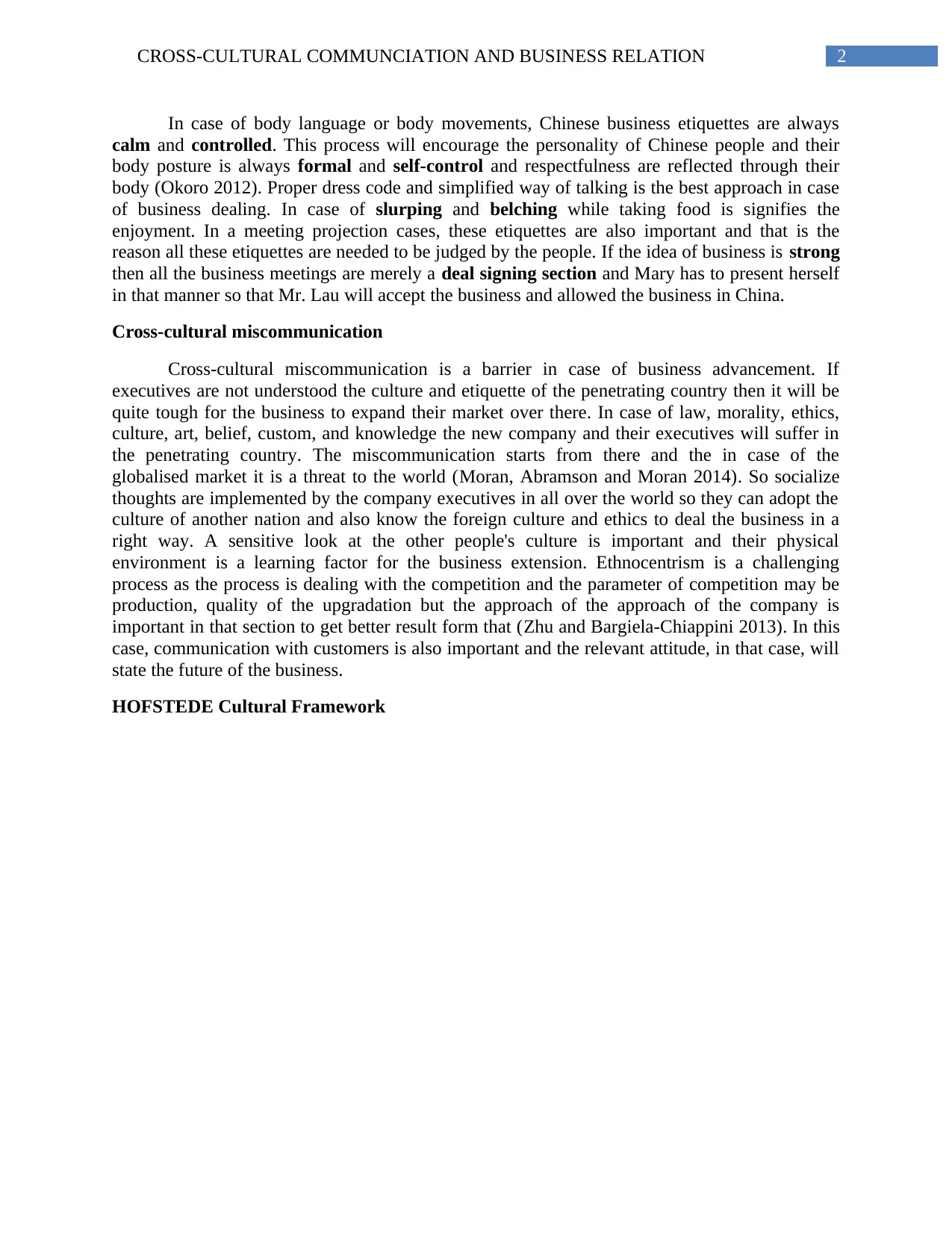
2CROSS-CULTURAL COMMUNCIATION AND BUSINESS RELATION
In case of body language or body movements, Chinese business etiquettes are always
calm and controlled. This process will encourage the personality of Chinese people and their
body posture is always formal and self-control and respectfulness are reflected through their
body (Okoro 2012). Proper dress code and simplified way of talking is the best approach in case
of business dealing. In case of slurping and belching while taking food is signifies the
enjoyment. In a meeting projection cases, these etiquettes are also important and that is the
reason all these etiquettes are needed to be judged by the people. If the idea of business is strong
then all the business meetings are merely a deal signing section and Mary has to present herself
in that manner so that Mr. Lau will accept the business and allowed the business in China.
Cross-cultural miscommunication
Cross-cultural miscommunication is a barrier in case of business advancement. If
executives are not understood the culture and etiquette of the penetrating country then it will be
quite tough for the business to expand their market over there. In case of law, morality, ethics,
culture, art, belief, custom, and knowledge the new company and their executives will suffer in
the penetrating country. The miscommunication starts from there and the in case of the
globalised market it is a threat to the world (Moran, Abramson and Moran 2014). So socialize
thoughts are implemented by the company executives in all over the world so they can adopt the
culture of another nation and also know the foreign culture and ethics to deal the business in a
right way. A sensitive look at the other people's culture is important and their physical
environment is a learning factor for the business extension. Ethnocentrism is a challenging
process as the process is dealing with the competition and the parameter of competition may be
production, quality of the upgradation but the approach of the approach of the company is
important in that section to get better result form that (Zhu and Bargiela-Chiappini 2013). In this
case, communication with customers is also important and the relevant attitude, in that case, will
state the future of the business.
HOFSTEDE Cultural Framework
In case of body language or body movements, Chinese business etiquettes are always
calm and controlled. This process will encourage the personality of Chinese people and their
body posture is always formal and self-control and respectfulness are reflected through their
body (Okoro 2012). Proper dress code and simplified way of talking is the best approach in case
of business dealing. In case of slurping and belching while taking food is signifies the
enjoyment. In a meeting projection cases, these etiquettes are also important and that is the
reason all these etiquettes are needed to be judged by the people. If the idea of business is strong
then all the business meetings are merely a deal signing section and Mary has to present herself
in that manner so that Mr. Lau will accept the business and allowed the business in China.
Cross-cultural miscommunication
Cross-cultural miscommunication is a barrier in case of business advancement. If
executives are not understood the culture and etiquette of the penetrating country then it will be
quite tough for the business to expand their market over there. In case of law, morality, ethics,
culture, art, belief, custom, and knowledge the new company and their executives will suffer in
the penetrating country. The miscommunication starts from there and the in case of the
globalised market it is a threat to the world (Moran, Abramson and Moran 2014). So socialize
thoughts are implemented by the company executives in all over the world so they can adopt the
culture of another nation and also know the foreign culture and ethics to deal the business in a
right way. A sensitive look at the other people's culture is important and their physical
environment is a learning factor for the business extension. Ethnocentrism is a challenging
process as the process is dealing with the competition and the parameter of competition may be
production, quality of the upgradation but the approach of the approach of the company is
important in that section to get better result form that (Zhu and Bargiela-Chiappini 2013). In this
case, communication with customers is also important and the relevant attitude, in that case, will
state the future of the business.
HOFSTEDE Cultural Framework
⊘ This is a preview!⊘
Do you want full access?
Subscribe today to unlock all pages.

Trusted by 1+ million students worldwide
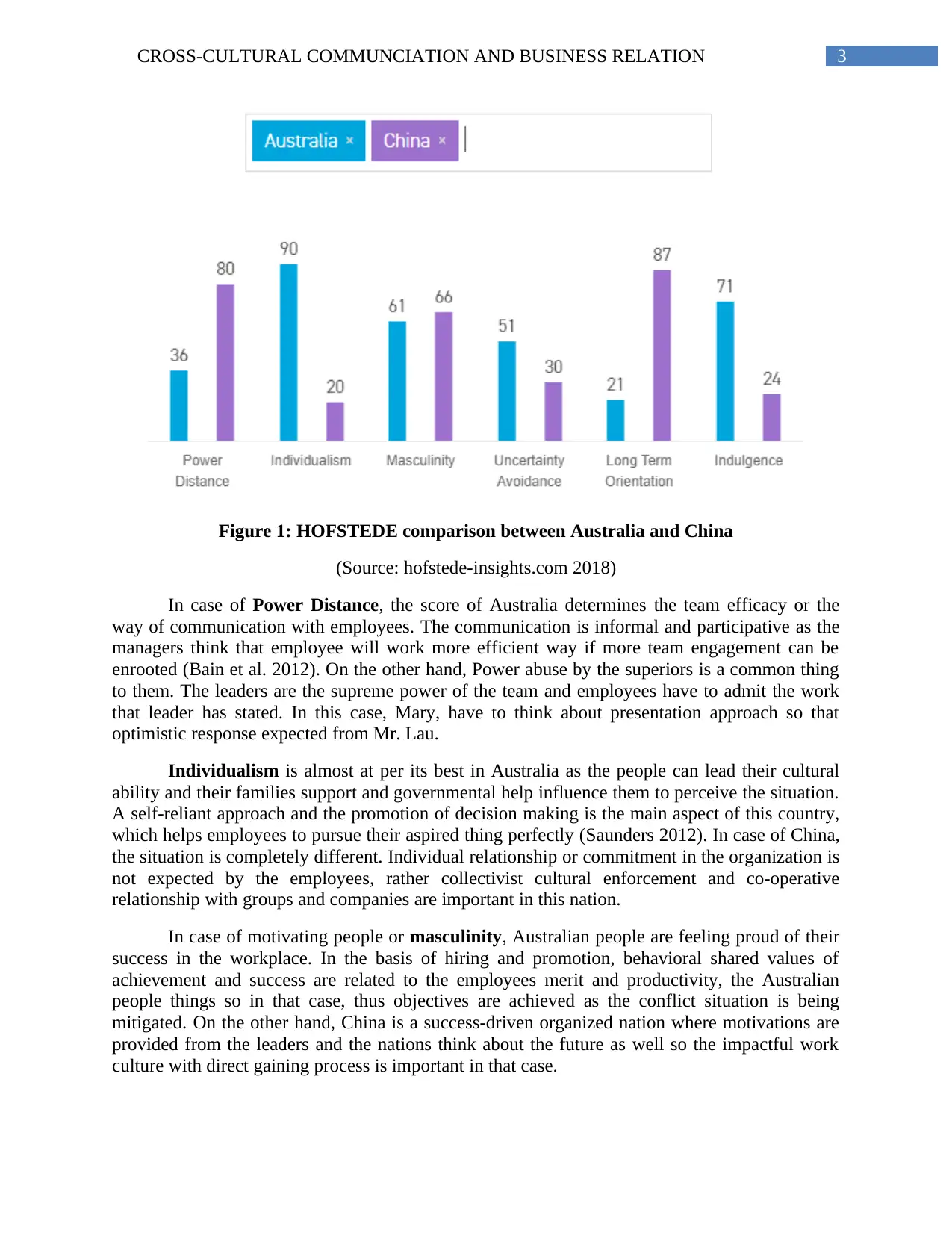
3CROSS-CULTURAL COMMUNCIATION AND BUSINESS RELATION
Figure 1: HOFSTEDE comparison between Australia and China
(Source: hofstede-insights.com 2018)
In case of Power Distance, the score of Australia determines the team efficacy or the
way of communication with employees. The communication is informal and participative as the
managers think that employee will work more efficient way if more team engagement can be
enrooted (Bain et al. 2012). On the other hand, Power abuse by the superiors is a common thing
to them. The leaders are the supreme power of the team and employees have to admit the work
that leader has stated. In this case, Mary, have to think about presentation approach so that
optimistic response expected from Mr. Lau.
Individualism is almost at per its best in Australia as the people can lead their cultural
ability and their families support and governmental help influence them to perceive the situation.
A self-reliant approach and the promotion of decision making is the main aspect of this country,
which helps employees to pursue their aspired thing perfectly (Saunders 2012). In case of China,
the situation is completely different. Individual relationship or commitment in the organization is
not expected by the employees, rather collectivist cultural enforcement and co-operative
relationship with groups and companies are important in this nation.
In case of motivating people or masculinity, Australian people are feeling proud of their
success in the workplace. In the basis of hiring and promotion, behavioral shared values of
achievement and success are related to the employees merit and productivity, the Australian
people things so in that case, thus objectives are achieved as the conflict situation is being
mitigated. On the other hand, China is a success-driven organized nation where motivations are
provided from the leaders and the nations think about the future as well so the impactful work
culture with direct gaining process is important in that case.
Figure 1: HOFSTEDE comparison between Australia and China
(Source: hofstede-insights.com 2018)
In case of Power Distance, the score of Australia determines the team efficacy or the
way of communication with employees. The communication is informal and participative as the
managers think that employee will work more efficient way if more team engagement can be
enrooted (Bain et al. 2012). On the other hand, Power abuse by the superiors is a common thing
to them. The leaders are the supreme power of the team and employees have to admit the work
that leader has stated. In this case, Mary, have to think about presentation approach so that
optimistic response expected from Mr. Lau.
Individualism is almost at per its best in Australia as the people can lead their cultural
ability and their families support and governmental help influence them to perceive the situation.
A self-reliant approach and the promotion of decision making is the main aspect of this country,
which helps employees to pursue their aspired thing perfectly (Saunders 2012). In case of China,
the situation is completely different. Individual relationship or commitment in the organization is
not expected by the employees, rather collectivist cultural enforcement and co-operative
relationship with groups and companies are important in this nation.
In case of motivating people or masculinity, Australian people are feeling proud of their
success in the workplace. In the basis of hiring and promotion, behavioral shared values of
achievement and success are related to the employees merit and productivity, the Australian
people things so in that case, thus objectives are achieved as the conflict situation is being
mitigated. On the other hand, China is a success-driven organized nation where motivations are
provided from the leaders and the nations think about the future as well so the impactful work
culture with direct gaining process is important in that case.
Paraphrase This Document
Need a fresh take? Get an instant paraphrase of this document with our AI Paraphraser
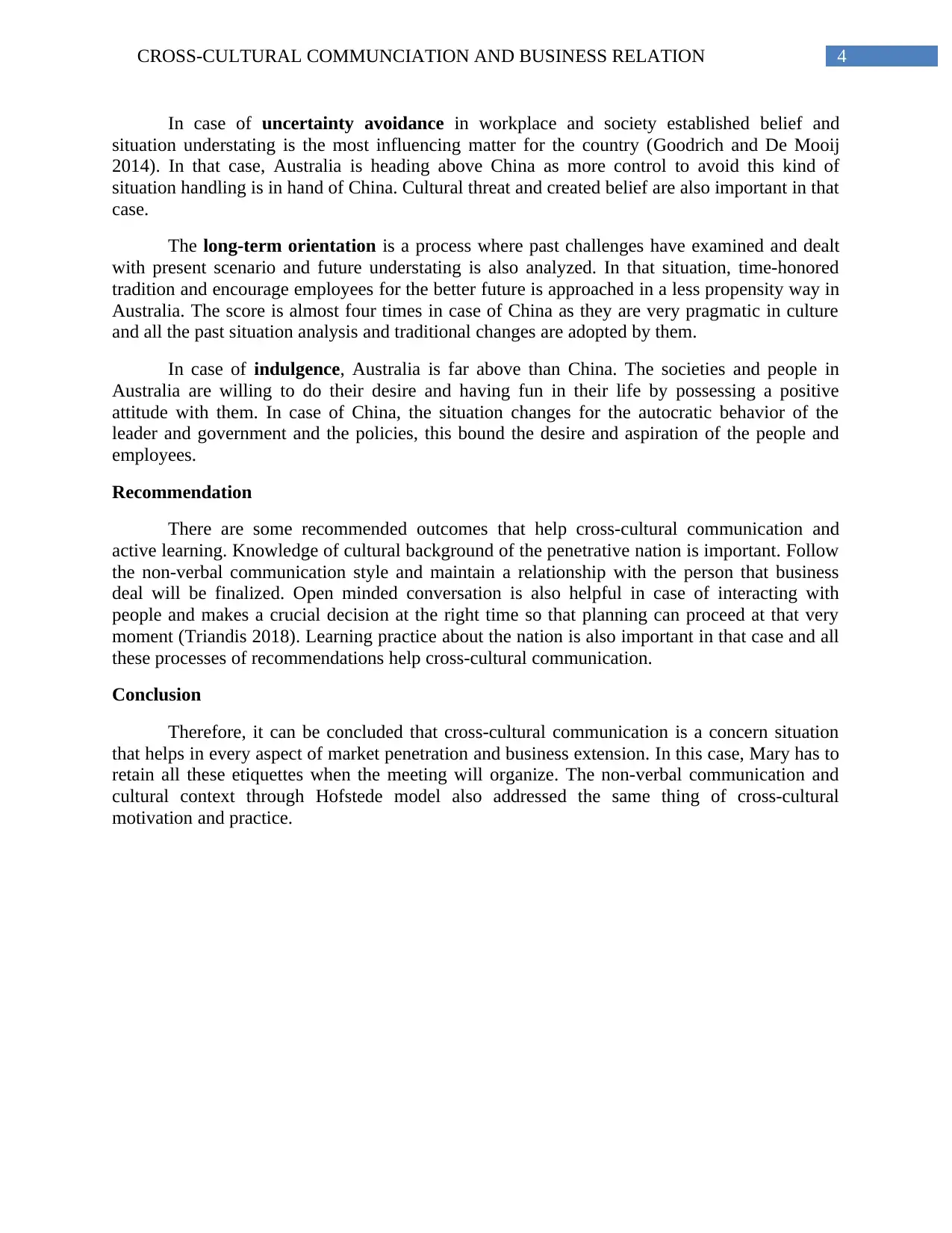
4CROSS-CULTURAL COMMUNCIATION AND BUSINESS RELATION
In case of uncertainty avoidance in workplace and society established belief and
situation understating is the most influencing matter for the country (Goodrich and De Mooij
2014). In that case, Australia is heading above China as more control to avoid this kind of
situation handling is in hand of China. Cultural threat and created belief are also important in that
case.
The long-term orientation is a process where past challenges have examined and dealt
with present scenario and future understating is also analyzed. In that situation, time-honored
tradition and encourage employees for the better future is approached in a less propensity way in
Australia. The score is almost four times in case of China as they are very pragmatic in culture
and all the past situation analysis and traditional changes are adopted by them.
In case of indulgence, Australia is far above than China. The societies and people in
Australia are willing to do their desire and having fun in their life by possessing a positive
attitude with them. In case of China, the situation changes for the autocratic behavior of the
leader and government and the policies, this bound the desire and aspiration of the people and
employees.
Recommendation
There are some recommended outcomes that help cross-cultural communication and
active learning. Knowledge of cultural background of the penetrative nation is important. Follow
the non-verbal communication style and maintain a relationship with the person that business
deal will be finalized. Open minded conversation is also helpful in case of interacting with
people and makes a crucial decision at the right time so that planning can proceed at that very
moment (Triandis 2018). Learning practice about the nation is also important in that case and all
these processes of recommendations help cross-cultural communication.
Conclusion
Therefore, it can be concluded that cross-cultural communication is a concern situation
that helps in every aspect of market penetration and business extension. In this case, Mary has to
retain all these etiquettes when the meeting will organize. The non-verbal communication and
cultural context through Hofstede model also addressed the same thing of cross-cultural
motivation and practice.
In case of uncertainty avoidance in workplace and society established belief and
situation understating is the most influencing matter for the country (Goodrich and De Mooij
2014). In that case, Australia is heading above China as more control to avoid this kind of
situation handling is in hand of China. Cultural threat and created belief are also important in that
case.
The long-term orientation is a process where past challenges have examined and dealt
with present scenario and future understating is also analyzed. In that situation, time-honored
tradition and encourage employees for the better future is approached in a less propensity way in
Australia. The score is almost four times in case of China as they are very pragmatic in culture
and all the past situation analysis and traditional changes are adopted by them.
In case of indulgence, Australia is far above than China. The societies and people in
Australia are willing to do their desire and having fun in their life by possessing a positive
attitude with them. In case of China, the situation changes for the autocratic behavior of the
leader and government and the policies, this bound the desire and aspiration of the people and
employees.
Recommendation
There are some recommended outcomes that help cross-cultural communication and
active learning. Knowledge of cultural background of the penetrative nation is important. Follow
the non-verbal communication style and maintain a relationship with the person that business
deal will be finalized. Open minded conversation is also helpful in case of interacting with
people and makes a crucial decision at the right time so that planning can proceed at that very
moment (Triandis 2018). Learning practice about the nation is also important in that case and all
these processes of recommendations help cross-cultural communication.
Conclusion
Therefore, it can be concluded that cross-cultural communication is a concern situation
that helps in every aspect of market penetration and business extension. In this case, Mary has to
retain all these etiquettes when the meeting will organize. The non-verbal communication and
cultural context through Hofstede model also addressed the same thing of cross-cultural
motivation and practice.
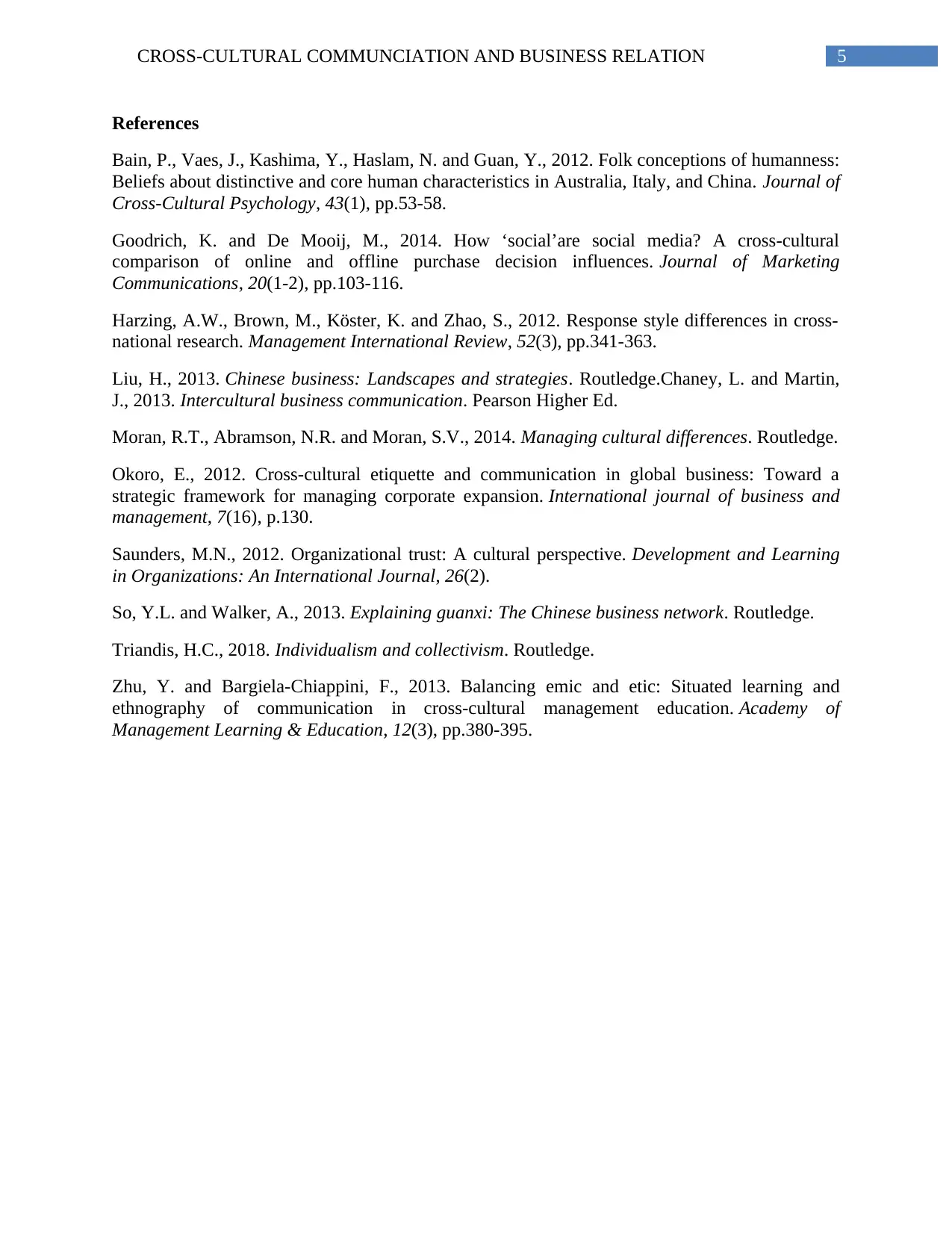
5CROSS-CULTURAL COMMUNCIATION AND BUSINESS RELATION
References
Bain, P., Vaes, J., Kashima, Y., Haslam, N. and Guan, Y., 2012. Folk conceptions of humanness:
Beliefs about distinctive and core human characteristics in Australia, Italy, and China. Journal of
Cross-Cultural Psychology, 43(1), pp.53-58.
Goodrich, K. and De Mooij, M., 2014. How ‘social’are social media? A cross-cultural
comparison of online and offline purchase decision influences. Journal of Marketing
Communications, 20(1-2), pp.103-116.
Harzing, A.W., Brown, M., Köster, K. and Zhao, S., 2012. Response style differences in cross-
national research. Management International Review, 52(3), pp.341-363.
Liu, H., 2013. Chinese business: Landscapes and strategies. Routledge.Chaney, L. and Martin,
J., 2013. Intercultural business communication. Pearson Higher Ed.
Moran, R.T., Abramson, N.R. and Moran, S.V., 2014. Managing cultural differences. Routledge.
Okoro, E., 2012. Cross-cultural etiquette and communication in global business: Toward a
strategic framework for managing corporate expansion. International journal of business and
management, 7(16), p.130.
Saunders, M.N., 2012. Organizational trust: A cultural perspective. Development and Learning
in Organizations: An International Journal, 26(2).
So, Y.L. and Walker, A., 2013. Explaining guanxi: The Chinese business network. Routledge.
Triandis, H.C., 2018. Individualism and collectivism. Routledge.
Zhu, Y. and Bargiela-Chiappini, F., 2013. Balancing emic and etic: Situated learning and
ethnography of communication in cross-cultural management education. Academy of
Management Learning & Education, 12(3), pp.380-395.
References
Bain, P., Vaes, J., Kashima, Y., Haslam, N. and Guan, Y., 2012. Folk conceptions of humanness:
Beliefs about distinctive and core human characteristics in Australia, Italy, and China. Journal of
Cross-Cultural Psychology, 43(1), pp.53-58.
Goodrich, K. and De Mooij, M., 2014. How ‘social’are social media? A cross-cultural
comparison of online and offline purchase decision influences. Journal of Marketing
Communications, 20(1-2), pp.103-116.
Harzing, A.W., Brown, M., Köster, K. and Zhao, S., 2012. Response style differences in cross-
national research. Management International Review, 52(3), pp.341-363.
Liu, H., 2013. Chinese business: Landscapes and strategies. Routledge.Chaney, L. and Martin,
J., 2013. Intercultural business communication. Pearson Higher Ed.
Moran, R.T., Abramson, N.R. and Moran, S.V., 2014. Managing cultural differences. Routledge.
Okoro, E., 2012. Cross-cultural etiquette and communication in global business: Toward a
strategic framework for managing corporate expansion. International journal of business and
management, 7(16), p.130.
Saunders, M.N., 2012. Organizational trust: A cultural perspective. Development and Learning
in Organizations: An International Journal, 26(2).
So, Y.L. and Walker, A., 2013. Explaining guanxi: The Chinese business network. Routledge.
Triandis, H.C., 2018. Individualism and collectivism. Routledge.
Zhu, Y. and Bargiela-Chiappini, F., 2013. Balancing emic and etic: Situated learning and
ethnography of communication in cross-cultural management education. Academy of
Management Learning & Education, 12(3), pp.380-395.
⊘ This is a preview!⊘
Do you want full access?
Subscribe today to unlock all pages.

Trusted by 1+ million students worldwide
1 out of 6
Related Documents
Your All-in-One AI-Powered Toolkit for Academic Success.
+13062052269
info@desklib.com
Available 24*7 on WhatsApp / Email
![[object Object]](/_next/static/media/star-bottom.7253800d.svg)
Unlock your academic potential
Copyright © 2020–2025 A2Z Services. All Rights Reserved. Developed and managed by ZUCOL.



